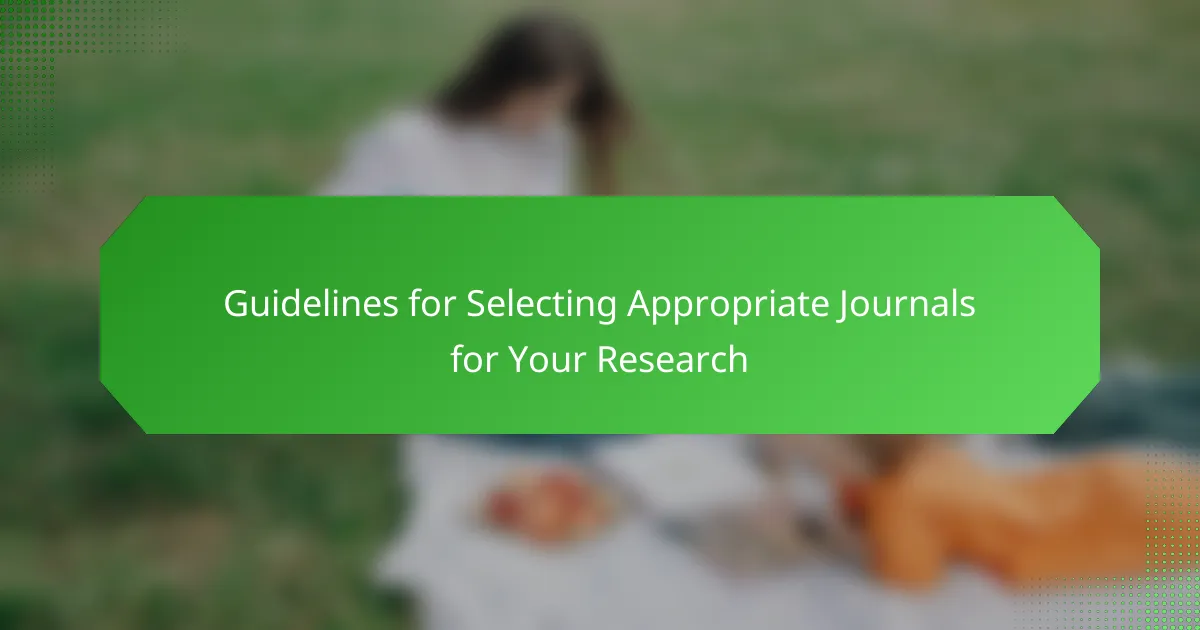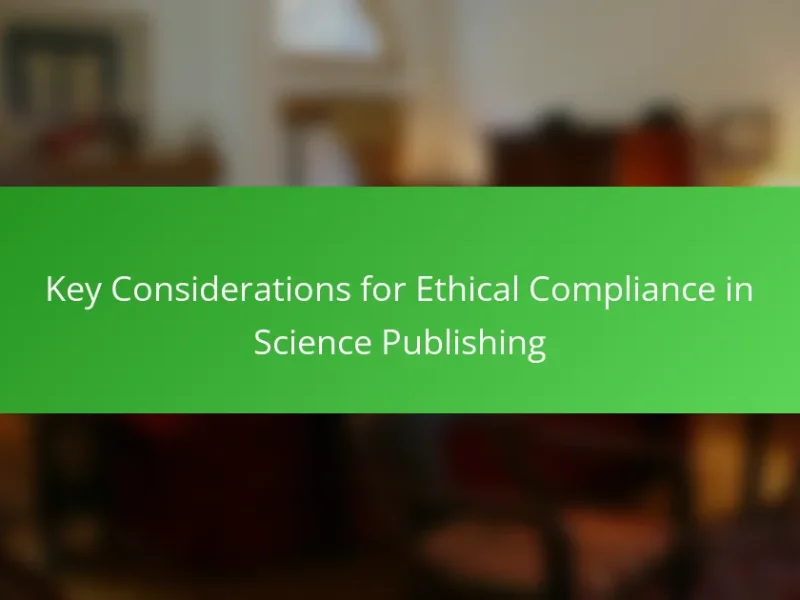Selecting appropriate journals for research involves evaluating several key factors. Researchers should assess the journal’s scope and audience to ensure alignment with their research topic and objectives. Important considerations include the journal’s impact factor, reputation, submission guidelines, review process duration, and acceptance rates. High-impact journals can enhance visibility, while adherence to formatting requirements can improve acceptance chances. Additionally, authors should be aware of open access options for broader dissemination and prepare for potential peer review feedback to increase the likelihood of successful publication.
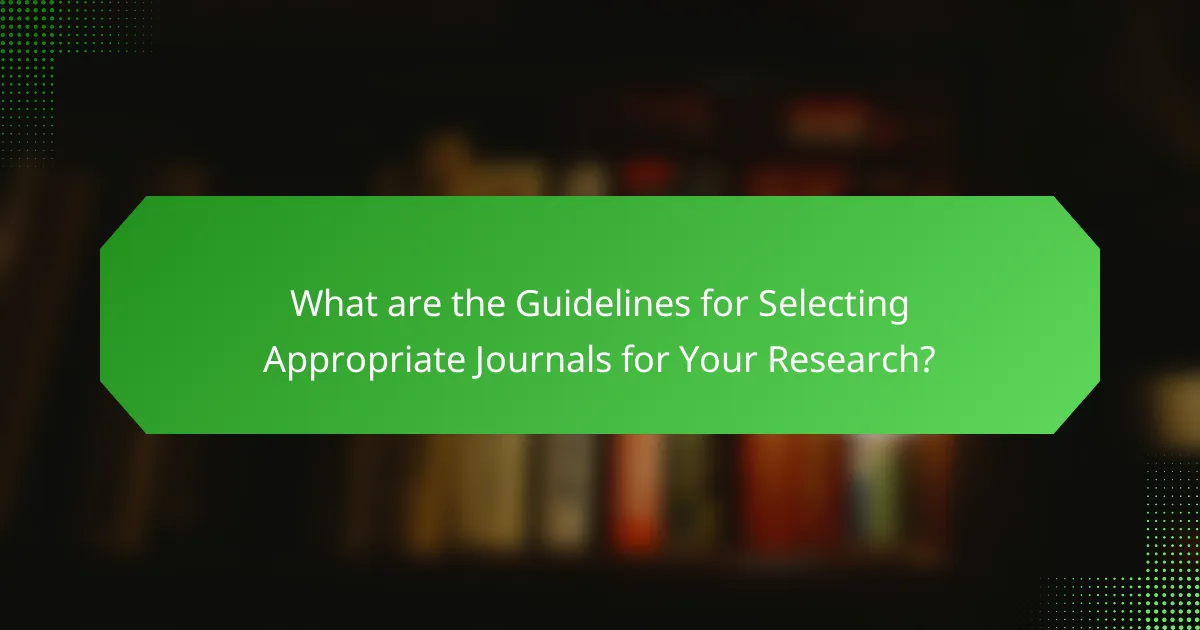
What are the Guidelines for Selecting Appropriate Journals for Your Research?
To select appropriate journals for your research, consider the journal’s scope and audience. Ensure the journal aligns with your research topic and target readership. Evaluate the journal’s impact factor and reputation within your field. High-impact journals often reach a broader audience. Review the journal’s submission guidelines for formatting and scope requirements. Adhering to these guidelines increases the likelihood of acceptance. Check the journal’s review process duration and acceptance rates. This information helps set expectations for publication timelines. Lastly, consider open access options for wider dissemination of your research.
Why is it important to choose the right journal for your research?
Choosing the right journal for your research is crucial for ensuring visibility and impact. The selected journal should align with the research’s scope and audience. A suitable journal enhances the likelihood of acceptance and publication. It also influences how the research is perceived within the academic community. Research published in well-matched journals tends to reach the appropriate readership. This can lead to increased citations and academic recognition. Furthermore, the right journal can enhance collaboration opportunities with other researchers. Ultimately, selecting the correct journal maximizes the research’s potential contributions to the field.
What impact does journal selection have on research visibility?
Journal selection significantly affects research visibility. Choosing a reputable journal increases the likelihood of wider readership and citation. High-impact journals often have established audiences and rigorous indexing. Research published in these journals typically gains more attention from peers. A study by the American Psychological Association found that articles in high-visibility journals receive up to 10 times more citations. Conversely, publishing in lesser-known journals can limit exposure and engagement. Thus, strategic journal selection is crucial for maximizing research impact.
How can journal choice influence academic career progression?
Journal choice significantly influences academic career progression. Publishing in high-impact journals enhances visibility and credibility. This recognition can lead to increased citations, which are crucial for career advancement. Research shows that articles in top-tier journals receive more attention from peers and funding bodies. Furthermore, tenure and promotion decisions often consider the quality of publications. A strategic journal selection aligns with the researcher’s field and audience. It can also foster networking opportunities within the academic community. Ultimately, the right journal can accelerate career growth and open doors to collaborations and grants.
What factors should be considered when selecting a journal?
When selecting a journal, consider the journal’s scope and audience. The scope defines the topics and research areas covered by the journal. Ensure your research aligns with these areas for appropriate placement.
Next, evaluate the journal’s impact factor and reputation. Journals with higher impact factors are often more respected in the academic community. This can enhance the visibility and credibility of your work.
Review the journal’s submission guidelines and review process. Understanding these requirements can save time and increase the chances of acceptance.
Check the journal’s open access policy. Open access journals can provide wider dissemination of your research. However, they may also involve publication fees.
Finally, consider the publication timeline. Some journals have faster turnaround times than others. A quicker publication can be crucial for timely research dissemination.
How does the scope of the journal relate to your research topic?
The scope of the journal is directly related to the research topic by defining the specific areas of study it covers. A journal’s scope outlines the themes, methodologies, and types of research it accepts. This ensures that submitted work aligns with the journal’s focus. For example, if your research is on environmental sustainability, selecting a journal that emphasizes ecological studies is crucial. Journals often provide detailed descriptions of their aims and scope on their websites. This information helps researchers identify suitable venues for their work. Matching your research to the journal’s scope increases the likelihood of acceptance and visibility.
What role does journal reputation play in selection?
Journal reputation significantly influences the selection process for publishing research. A reputable journal is often perceived as having higher quality standards. Researchers aim for journals with strong impact factors and rigorous peer-review processes. These factors enhance the visibility and credibility of their work. Studies show that articles published in high-reputation journals receive more citations. This can lead to greater academic recognition and career advancement. Additionally, funding bodies and institutions may favor research published in respected journals. Therefore, journal reputation plays a critical role in both selection and the potential impact of the research.
How important are the journal’s audience and readership?
The journal’s audience and readership are crucial for its impact and relevance. A well-defined audience ensures that the research reaches the right people. This enhances the likelihood of citations and engagement. Readership demographics can influence the journal’s editorial decisions and content focus. Research shows that journals with a targeted audience often achieve higher impact factors. For example, a study by the American Psychological Association highlights that journals with specific readerships see increased submission rates. Therefore, understanding the audience and readership is essential for maximizing a journal’s influence in the academic community.
What are the common types of journals available for researchers?
The common types of journals available for researchers include peer-reviewed journals, open-access journals, and trade journals. Peer-reviewed journals publish articles that have been evaluated by experts in the field. Open-access journals allow free access to their content without subscription fees. Trade journals focus on specific industries and provide practical insights rather than original research. These categories help researchers choose the right platform for their work.
What distinguishes peer-reviewed journals from non-peer-reviewed journals?
Peer-reviewed journals undergo a rigorous evaluation process by experts in the field before publication. This process ensures the quality and credibility of the research presented. Non-peer-reviewed journals do not have this level of scrutiny. As a result, they may publish content that lacks validation or reliability. Peer-reviewed articles typically include a detailed methodology and references to support findings. This transparency enhances the trustworthiness of the research. In contrast, non-peer-reviewed articles may not adhere to such standards. The peer-review process helps to filter out flawed studies, providing a higher standard of academic integrity.
How do open-access journals differ from traditional subscription-based journals?
Open-access journals allow free access to their content for all readers. In contrast, traditional subscription-based journals require payment or institutional access for readers to view articles. Open-access models often charge authors publication fees, making research available to a wider audience. Traditional journals rely on subscriptions for funding, limiting access to those who can pay. According to a 2016 study by the European Commission, open-access articles receive 18% more citations than subscription-based articles. This indicates broader visibility and impact for research published in open-access formats.
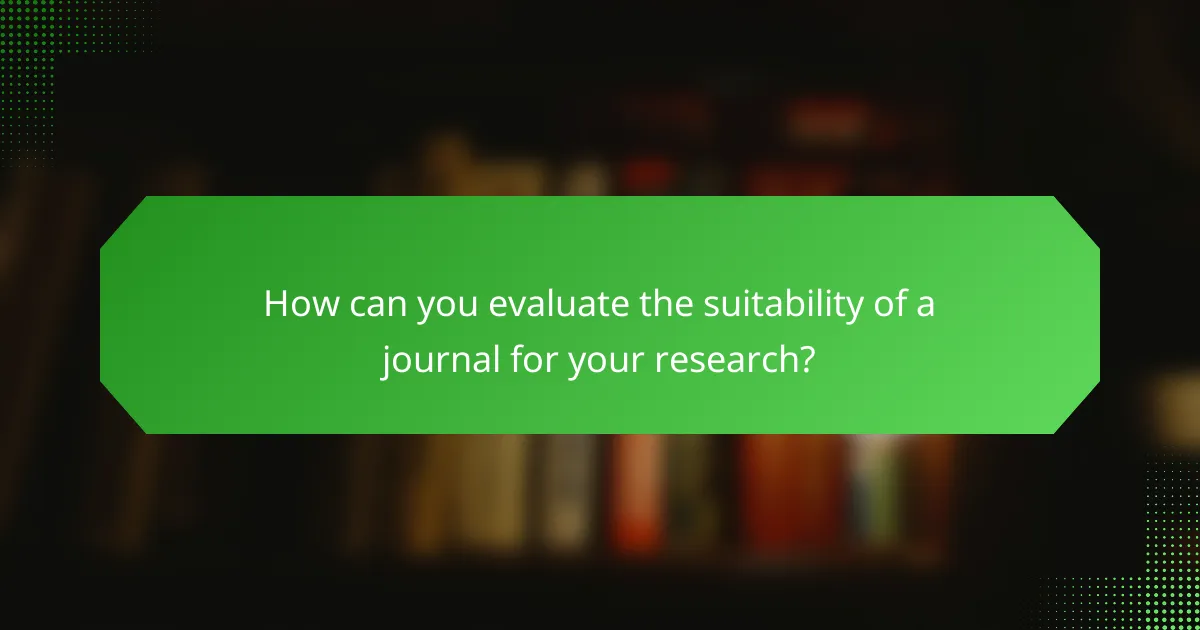
How can you evaluate the suitability of a journal for your research?
To evaluate the suitability of a journal for your research, assess its scope and audience. Determine if the journal aligns with your research topic and objectives. Review the journal’s aims and scope statement, usually found on its website. Check the journal’s indexing and impact factor to gauge its reputation. Analyze the types of articles previously published in the journal. Ensure your research fits within their publication criteria. Additionally, consider the journal’s review process and publication timeline. These factors collectively indicate the journal’s appropriateness for your work.
What tools and resources can help assess journal quality?
Tools and resources that help assess journal quality include journal metrics, databases, and evaluation platforms. Journal metrics like Impact Factor and h-index provide quantitative measures of journal influence. Databases such as Scopus and Web of Science offer comprehensive journal rankings and citation data. Evaluation platforms like Journal Citation Reports and Scimago Journal Rank provide insights into journal performance and reputation. These tools enable researchers to make informed decisions about where to submit their work. The use of these resources is supported by their widespread adoption in academic publishing.
How can impact factors and citation metrics guide your decision?
Impact factors and citation metrics can guide your decision by indicating a journal’s influence and reach within the academic community. A high impact factor suggests that articles published in that journal are frequently cited, reflecting their significance. Citation metrics provide quantitative data on how often research is referenced, helping you assess a journal’s reputation. Choosing journals with higher metrics can enhance the visibility and credibility of your work. According to the Journal Citation Reports, journals in the top quartile have an impact factor above 3.0, which is often associated with rigorous peer review and quality standards. This data can directly influence your selection of journals to submit your research for publication.
What role do journal indexing and databases play in evaluation?
Journal indexing and databases are critical for evaluating academic research. They provide a structured way to assess the quality and impact of journals. Indexing services, such as Scopus and Web of Science, evaluate journals based on citation metrics. These metrics include the Journal Impact Factor, which reflects the average number of citations to articles published in the journal. Access to indexed journals is often viewed as a mark of credibility in academia. Databases facilitate the discovery of relevant literature, enabling researchers to identify key studies in their field. Researchers often rely on these resources to select journals that align with their work’s scope and audience. The presence of a journal in reputable databases can influence publication decisions and funding opportunities.
What steps can you take to ensure your manuscript fits the journal’s requirements?
Review the journal’s author guidelines for specific requirements. These guidelines outline formatting, structure, and length expectations. Ensure your manuscript adheres to the specified citation style. Common styles include APA, MLA, or Chicago. Tailor your content to fit the journal’s scope and focus. This alignment increases the chances of acceptance. Check for word count limits and adjust your manuscript accordingly. Many journals have strict limits. Submit all required supplementary materials, such as figures or tables. Failure to include these can lead to rejection. Lastly, consider peer-reviewed articles from the journal for insights into successful submissions. This practice helps you understand what the journal values.
How can you align your manuscript with the journal’s aims and scope?
To align your manuscript with the journal’s aims and scope, thoroughly review the journal’s guidelines. Identify the specific topics and themes the journal prioritizes. Ensure your research fits within these themes. Tailor your manuscript to reflect the journal’s preferred structure and formatting. Incorporate relevant keywords that resonate with the journal’s focus. Highlight how your findings contribute to the journal’s objectives. This alignment increases the likelihood of acceptance. Journals often provide detailed aims and scope sections on their websites. Referencing these can substantiate your alignment efforts.
What formatting and submission guidelines should you follow?
Formatting and submission guidelines vary by journal. Authors must carefully review the specific journal’s requirements. Common formatting elements include font type, font size, and margin specifications. Many journals prefer a standard font like Times New Roman, size 12. Margins are often set to one inch on all sides.
Submission guidelines typically outline the required sections of the manuscript. These sections usually include an abstract, introduction, methodology, results, and discussion. Some journals require specific referencing styles, such as APA or MLA.
Additionally, authors may need to submit supplementary materials, such as data sets or images. Adhering to these guidelines ensures a smoother review process. Failure to comply can result in delays or rejection of the manuscript.
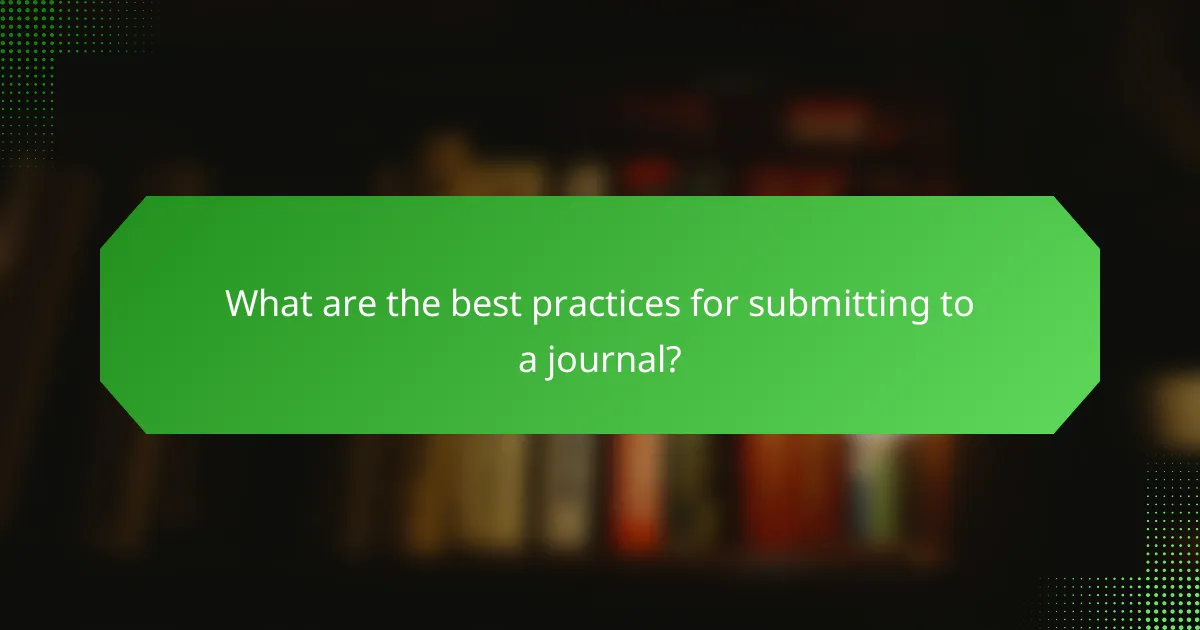
What are the best practices for submitting to a journal?
The best practices for submitting to a journal include thoroughly reviewing the journal’s submission guidelines. Each journal has specific requirements for formatting and length. Authors should ensure their manuscript aligns with the journal’s scope and audience. It is essential to conduct a plagiarism check before submission. Many journals use plagiarism detection software. Authors should prepare a compelling cover letter that summarizes the significance of their research. Clear and concise writing enhances the chances of acceptance. Finally, authors should be prepared for peer review feedback, which may require revisions. These practices increase the likelihood of successful publication.
How can you prepare your manuscript for submission?
To prepare your manuscript for submission, ensure it meets the journal’s specific guidelines. Review the journal’s submission requirements, including formatting, length, and style. Organize your manuscript into sections: title, abstract, introduction, methods, results, discussion, and references. Check for clarity and coherence in your writing. Ensure all figures and tables are properly labeled and referenced in the text. Conduct a thorough proofreading to eliminate grammatical errors and typos. Confirm that all necessary ethical approvals and disclosures are included. Finally, prepare a cover letter that summarizes your research and its significance. Following these steps increases the likelihood of a successful submission.
What common mistakes should you avoid during the submission process?
Common mistakes to avoid during the submission process include failing to follow journal guidelines. Each journal has specific formatting and submission requirements. Ignoring these can lead to immediate rejection. Another mistake is submitting to an inappropriate journal. Selecting a journal that does not align with your research focus can waste time. Additionally, not proofreading your manuscript is a critical error. Typos and grammatical mistakes can undermine your credibility. Failing to include necessary supplementary materials is also common. Journals often require specific documents, such as cover letters or conflict of interest statements. Lastly, missing deadlines can jeopardize your submission. Always be aware of submission timelines to avoid complications.
How can you effectively communicate with journal editors?
To effectively communicate with journal editors, maintain professionalism and clarity in your correspondence. Begin with a clear subject line that summarizes your message. Use formal language and address the editor by their title and last name. Clearly state your purpose, whether it’s an inquiry, submission, or follow-up. Provide necessary details succinctly to avoid confusion. Attach relevant documents, such as your manuscript or cover letter, if applicable. Be patient and respectful in your tone. Editors manage many submissions and may take time to respond. Following these guidelines enhances the likelihood of a positive interaction.
What tips can enhance your chances of acceptance in a journal?
To enhance your chances of acceptance in a journal, ensure your manuscript aligns with the journal’s scope. Review the journal’s aims and scope carefully before submission. Follow the journal’s submission guidelines meticulously, including formatting and citation style. Present clear, concise, and well-structured writing throughout your manuscript. Highlight the significance and originality of your research in the introduction. Include comprehensive literature reviews to position your work within existing research. Engage with recent articles published in the journal to understand their preferences. Consider seeking feedback from colleagues before submission to improve your manuscript quality. These practices increase the likelihood of acceptance based on established academic standards.
How can you leverage feedback from peers before submission?
You can leverage feedback from peers before submission by actively seeking their insights on your work. Engaging colleagues can provide different perspectives that enhance your research quality. They may identify gaps in your arguments or suggest areas for improvement. Peer feedback can also help clarify your findings and strengthen your conclusions. Additionally, discussing your manuscript with peers can reveal whether your work aligns with journal expectations. Research shows that incorporating peer feedback increases the likelihood of acceptance in academic journals. A study published in the “Journal of Scholarly Publishing” found that manuscripts revised based on peer input had a significantly higher acceptance rate.
What strategies can improve the clarity and impact of your writing?
To improve the clarity and impact of your writing, focus on concise language and clear structure. Use short sentences to convey ideas effectively. Avoid jargon unless necessary, and define complex terms. Organize content logically with headings and subheadings. Each paragraph should contain a single main idea. Utilize active voice to enhance engagement. Edit ruthlessly to remove unnecessary words. According to a study by the University of Oxford, clarity in writing significantly increases reader comprehension and retention.
The main entity of this article is the guidelines for selecting appropriate journals for research. The article outlines essential factors for journal selection, including alignment with research scope and audience, impact factor, and submission guidelines. It emphasizes the importance of choosing the right journal for maximizing research visibility, citations, and academic career progression. Additionally, the article discusses common types of journals, the significance of peer review, and best practices for manuscript preparation and submission. By following these guidelines, researchers can enhance their chances of successful publication and improve the impact of their work within the academic community.
